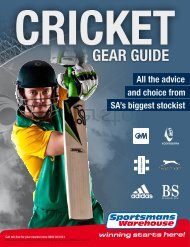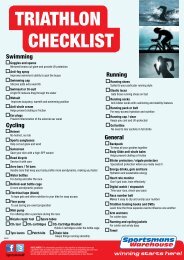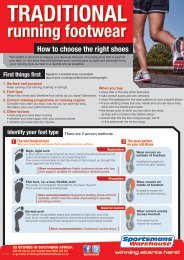Sportsmans Warehouse
Sportsmans Warehouse
Sportsmans Warehouse
You also want an ePaper? Increase the reach of your titles
YUMPU automatically turns print PDFs into web optimized ePapers that Google loves.
KicK scOOTer components<br />
deck • head tube • headset • grip tape • fork • handlebars • wheels • bearings • brakes • folding action<br />
Deck<br />
Material: Most of the modern, urban kick scooters have decks made from lightweight<br />
aluminium or steel. Quality scooters are made from 100% aircraft-grade<br />
aluminium. Some do, however, have wood laminate or wood-and-fibreglass<br />
laminate decks. A urethane cushion might be placed between the deck and the frame for shock-absorption.<br />
Size: Decks range in length between about 16 and 23 inches (40 and 58 cm) and the most common widths are<br />
4½” and 4” (11,5 and 10 cm). Wider decks suit bigger riders with bigger feet, while narrower decks are easier<br />
to handle for the smaller or inexperienced rider. Cruiser kick scooters are wider, offering more foot space and a<br />
smooth ride. Some children’s scooters have wider decks for stability.<br />
construction: Scooters used for tricks can have decks that are reinforced, thicker and double-welded to the<br />
down-tube. All scooters are rated to carry up to certain maximum weights of rider.<br />
heaD tuBe<br />
This is the front part of the deck where the fork and bars are mounted. Head tubes are available in several<br />
angles to provide a choice of feel when riding.<br />
heaDSet<br />
This component is fitted into the head tube and is designed to keep the fork on the scooter.<br />
It can be threaded or threadless and the kind of headset you choose will determine the<br />
kind of fork you can ride.<br />
Grip tape<br />
This rough material must be applied, just as on a skateboard, to help your feet grip the deck.<br />
Fork<br />
The fork fits into the head tube. Forks can be threaded or threadless. Aluminium forks are usually<br />
fork<br />
threadless, while steel forks are usually threadless but can be threaded. The handlebar piece is<br />
fitted into the fork and kept in place with a collar clamp, which must be strong and solid, particularly<br />
for tricks. Double, triple and quadruple clamps are available. The fork is compatible with the wheel size.<br />
hanDleBarS<br />
pieces: One-piece and three-piece bars are available. One-piece bars are usually made<br />
from 4130 chromoly steel, but aluminium bars are beginning to appear.<br />
headset<br />
height adjustment: Many handlebars are adjustable from 22 up to 36 inches (56 to 91 cm) and can be moved<br />
by means of a quick-release or push pin. Some scooters offer a choice of fixed-height (and width) handlebars.<br />
The ideal height for handlebars is at the level of the rider’s navel.<br />
Steering: Most scooters have T-style handlebars which you turn to steer the scooter. Some scooters have fixed<br />
handlebars which only serve to balance the rider, who has to lean in order to turn the scooter. Others have ballstyle<br />
handlebars with a simple rubber ball-grip, serving to balance the rider who rides the scooter surfer-style,<br />
leaning side-to-side to turn.<br />
Grips: These are usually soft rubber. Some have extra-thick foam padding, while other, high-end trick scooters<br />
have low-profile grips to enhance mobility.<br />
clamp<br />
bar<br />
head tube<br />
grip<br />
clamp<br />
folding mechanism<br />
deck<br />
WheelS<br />
Size: Diameters start at about 110 mm and<br />
go up to just over 200 mm, depending on<br />
the size and design of the scooter.<br />
Smaller wheels go reasonably fast and smoothly and are<br />
more suitable for tricks. Larger wheels will cope with uneven<br />
pavements more easily, but are not recommended for tricks.<br />
Material: Smaller (standard) wheels are usually made of<br />
solid polyurethane with a small hub. Larger wheels generally<br />
have a spoked metal construction covered by a thin, polyurethane tyre.<br />
BearinGS<br />
Each wheel has two bearings and a bearer spacer in the middle to prevent<br />
damage from over-tightening.<br />
Replacement bearings are available in sets of four. The American ABEC scale for<br />
bearings applies, with higher ratings providing faster rolling with less friction.<br />
ABEC 5 is the norm for many kick scooters<br />
ABEC 7 bearings are used in some highly spec’d trick scooters<br />
BrakeS<br />
The most common is a very simple fender brake.<br />
The rider steps on the rear fender which is mounted on a hinged spring,<br />
then the fender presses against the wheel to stop it.<br />
grip tape<br />
FolDinG action<br />
brake<br />
Most scooters fold up quickly and easily. Simply unlock the joint<br />
release lever, fold the scooter and re-lock the mechanism to hold<br />
the scooter in the folded position. Compact folded size and light<br />
weight make these scooters extremely portable.<br />
Pro scooters used for tricks are typically not foldable.<br />
three-WheeleD DeSiGn<br />
wheel with bearings<br />
smooth<br />
your ride<br />
These scooters are suitable for younger children, as they are more stable,<br />
closer to the ground and have an easy stick steering mechanism.<br />
E&OE







